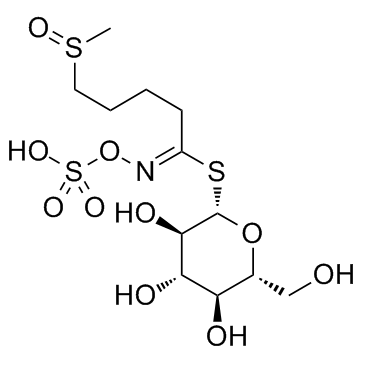Glucoraphanin |
| Catalog No.GC32999 |
Glucoraphanin, a natural glucosinolate found in cruciferous vegetable, is a stable precursor of the Nrf2 inducer sulforaphane, which possesses antioxidant, anti-inflammatory, and anti-carcinogenic effects.
Products are for research use only. Not for human use. We do not sell to patients.

Cas No.: 21414-41-5
Sample solution is provided at 25 µL, 10mM.
Glucoraphanin, a natural glucosinolate found in cruciferous vegetable, is a stable precursor of the Nrf2 inducer sulforaphane, which possesses antioxidant, anti-inflammatory, and anti-carcinogenic effects.
Glucoraphanin reduces weight gain and increases energy expenditure in HFD-fed mice. Glucoraphanin can improves insulin sensitivity and glucose tolerance in HFD-fed mice. However, Glucoraphanin does not exert antiobesity and insulin-sensitizing effects in Nrf2-/- Mice. Glucoraphanin blocks HFD-induced reduction of Ucp1 protein levels in white adipose depots of wild-type mice but not in Nrf2-/- mice. Glucoraphanin alleviates HFD-induced hepatic steatosis and oxidative stress. Glucoraphanin suppresses HFD-induced proinflammatory activation of macrophages in liver and adipose tissue. Glucoraphanin also decreases circulating LPS and the relative abundance of proteobacteria in the gut microbiomes of HFD-fed mice[1]. Mice with pellets including 0.1% Glucoraphanin (GF) significantly attenuates the decreased social avoidance time in stressed mice. In the 1% sucrose preference test (SPT), treatment with pellets including 0.1% GF significantly attenuates the decreased sucrose preference of stressed mice[2].
[1]. Nagata N, et al. Glucoraphanin Ameliorates Obesity and Insulin Resistance Through Adipose Tissue Browning and Reduction of Metabolic Endotoxemia in Mice. Diabetes. 2017 May;66(5):1222-1236. [2]. Yao W, et al. Role of Keap1-Nrf2 signaling in depression and dietary intake of glucoraphanin confers stress resilience in mice. Sci Rep. 2016 Jul 29;6:30659.
Average Rating: 5 (Based on Reviews and 23 reference(s) in Google Scholar.)
GLPBIO products are for RESEARCH USE ONLY. Please make sure your review or question is research based.
Required fields are marked with *




















